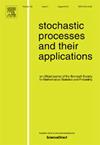非马尔可夫动力学和共噪声下平均场最优停车的极限理论
IF 1.2
2区 数学
Q3 STATISTICS & PROBABILITY
引用次数: 0
摘要
受Talbi等人(2025,2022)的启发,本文关注具有非马尔可夫动态和共同噪声的平均场最优停止问题。目的是建立极限理论,并证明弱公式与强公式之间的值函数的等价性。强和弱公式的区别在于决定正则空间上停止时间的随机性来源。在强公式中,停止时间的随机性来源于布朗运动。相反,在弱公式中不一定是这种情况。此外,还引入了一个(H)-假设型条件来保证值函数的等价性。极限理论包含了大种群最优停车问题的值函数和解向平均场极限的收敛性,并证明了平均场最优停车问题的每一个解都可以被大种群最优停车问题的解逼近。本文章由计算机程序翻译,如有差异,请以英文原文为准。
On the limit theory of mean field optimal stopping with non-Markov dynamics and common noise
This paper focuses on a mean-field optimal stopping problem with non-Markov dynamics and common noise, inspired by Talbi et al. (2025,2022). The goal is to establish the limit theory and demonstrate the equivalence of the value functions between weak and strong formulations. The difference between the strong and weak formulations lies in the source of randomness determining the stopping time on a canonical space. In the strong formulation, the randomness of the stopping time originates from Brownian motions. In contrast, this may not necessarily be the case in the weak formulation. Additionally, a -Hypothesis-type condition is introduced to guarantee the equivalence of the value functions. The limit theory encompasses the convergence of the value functions and solutions of the large population optimal stopping problem towards those of the mean-field limit, and it shows that every solution of the mean field optimal stopping problem can be approximated by solutions of the large population optimal stopping problem.
求助全文
通过发布文献求助,成功后即可免费获取论文全文。
去求助
来源期刊

Stochastic Processes and their Applications
数学-统计学与概率论
CiteScore
2.90
自引率
7.10%
发文量
180
审稿时长
23.6 weeks
期刊介绍:
Stochastic Processes and their Applications publishes papers on the theory and applications of stochastic processes. It is concerned with concepts and techniques, and is oriented towards a broad spectrum of mathematical, scientific and engineering interests.
Characterization, structural properties, inference and control of stochastic processes are covered. The journal is exacting and scholarly in its standards. Every effort is made to promote innovation, vitality, and communication between disciplines. All papers are refereed.
 求助内容:
求助内容: 应助结果提醒方式:
应助结果提醒方式:


